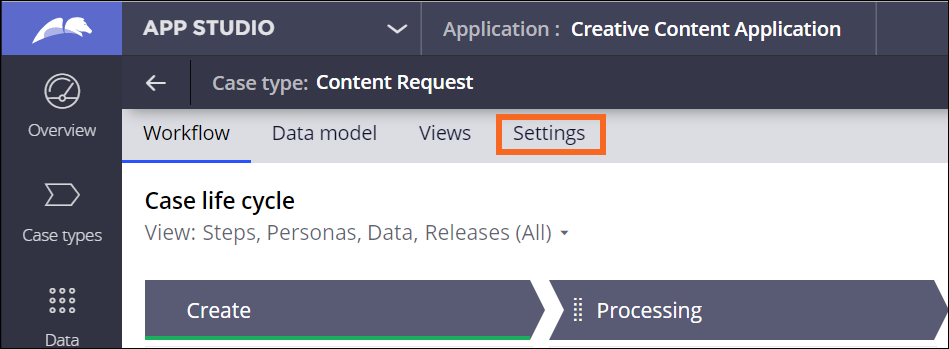
Designing an approval process
Automating the approval process is another value-added feature of Pega applications. In Pega Platform™, the approval process is a decision point, where an individual decides to approve or reject a case.
For Ren, there are two different points in the process that require approval. The first is the approval of the team supervisor, Gab. The second approval is from the Requester. The sequence of events for Ren’s ideal process flow is as follows:
- When a Creative Content team member completes a project, it is routed to the team supervisor, Gab, for review and approval.
- If Gab approves, the project is routed to the Requester for review and approval.
- If the Requester approves the project, the case is resolved.
The Approve/Reject steps associated with Ren's ideal process flow are already set in the Content Request case type. They are labeled Supervisor Approval and Requester Approval.
Each Approve/Reject step, identified by the checkmark icon, marks a decision point in the case type that requires human interaction. Ren can configure the actions that are taken in response to either the Supervisor or Requester approving or rejecting the content submission.
With the approval steps in place, Ren's next task is to configure the routing.
Routing the approvals
As with the Collect information steps, Ren's routing choices for an approval step are:
- Specific user
- Work queue
- Use business logic
To design the approval process, Ren selects Specific user for both the Supervisor Approval and Requester Approval steps.
To route work for the Supervisor Approval step, Ren does the following:
- Click the Supervisor Approval step to open the contextual property pane on the right.
- On the General tab, under the Route to section, enter the following information into the fields:
- Specific user
- User name
- Gab@abctech
Ren follows similar steps for the Requester Approval step:
- Click the Requester Approval step to open the contextual property pane.
- Under the Route to section, enter the following information into the fields:
- Specific user
- Participant
- Owner
Creating the Owner participant
In a Pega application, the Owner is defined as the individual that first initiated the case. For Ren's Content Request case type, the Owner and the Requester are the same.
Ren must activate the Owner participant profile for the application to work properly. To do this, Ren completes the following steps:
- In the Content Request case life cycle window, click the Settings tab.
- In the menu that is displayed, select Participants.
- Click .
- Select the Create participant automatically when the case starts check box.
- Click .
- Click the Workflow tab to return to the Content Request case life cycle window.
- In the Content Request window, click .
Next, Ren configures the views for each approval step.
Configuring the views
In Pega applications, a "view" is what the end-user sees when they access the live application. The views for both the supervisor and requester approval steps will be similar.
The Supervisor Approval step will contain a single new field called Supervisor review.
Ren completes the following steps to create the view:
- Click the Supervisor Approval step to open the contextual property pane.
- On the General tab, click .
- Click the icon to delete the Notes field.
- Click +Add field.
- In the Field name field, enter Supervisor review.
- In the Type list, select
- Click for the field.
- Click for the view.
- Click .
Ren repeats the steps above to create a similar view for the Requestor Approval step.
Enabling email and mobile approval
Ren and Gab have decided to enable approval for both email and mobile devices. This allows the case to be approved or rejected outside of the Pega application and the User Portal.
In both cases, the user specified in the routing will receive a notification via email, text, or both, as in this case. The user will be able to access the project and process the approval or rejection from within the notification.
To configure the functionality for the Supervisor Approval step, Ren completes the following steps:
- Click on the Supervisor Approval step to open the contextual property pane.
- On the General tab, in the Enable approval from section, select both the Email and Mobile check boxes.
- Ren has decided to use the default templates for both the Email subject/Push notification messages and the Email Content sections, so no changes need to be made to these settings.
- Select the Included attachments check box.
- Select the All case attachments radio button.
- Click .
Ren follows the same steps to configure email and mobile notifications for the Requester Approval step.
In the following image, drag the center handle to see how the Requester Approval step is configured, and how it is displayed in the user portal:
Review the following video to see Ren design the approval process for both the Supervisor Approval and Requester Approval steps.
Note: The following video has no audio and no closed captions.
Check your knowledge with the following interaction:
In your environment
In your own Pega environment, configure an approval process. You can mirror Ren’s application, or configure the approval process for your own situation.
If you are having problems with your training, please review the Pega Academy Support FAQs.
Want to help us improve this content?

